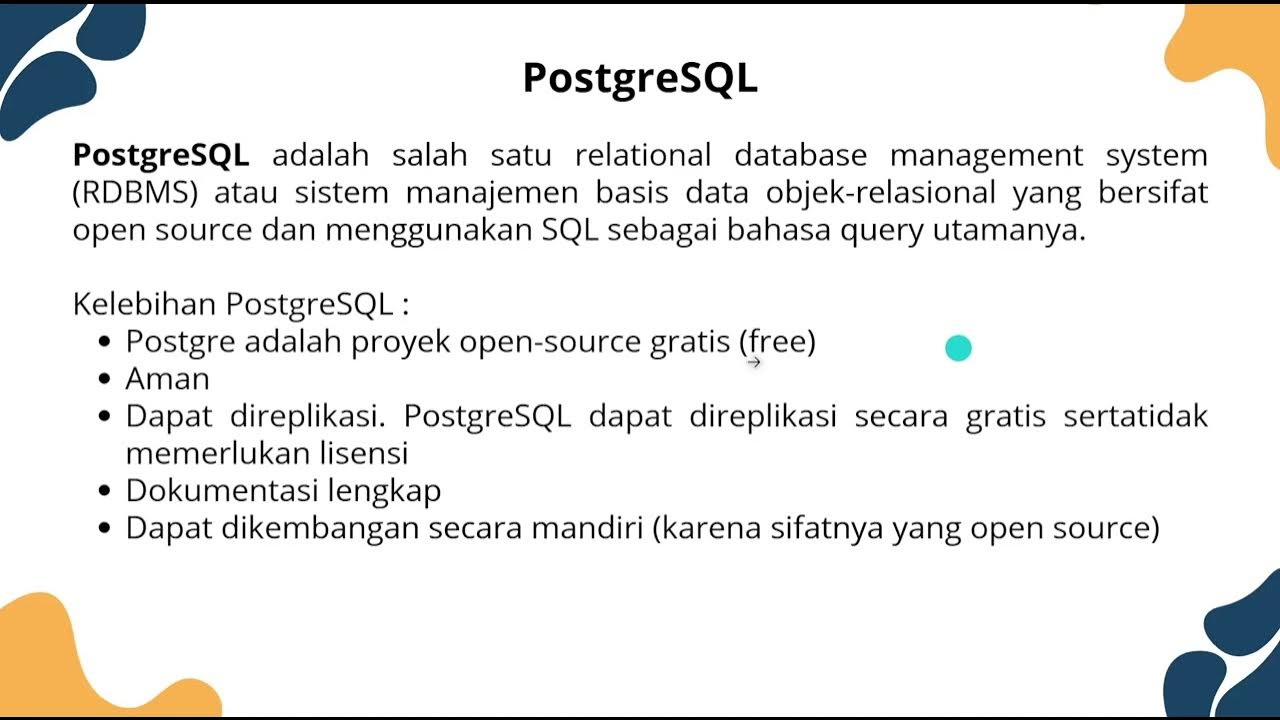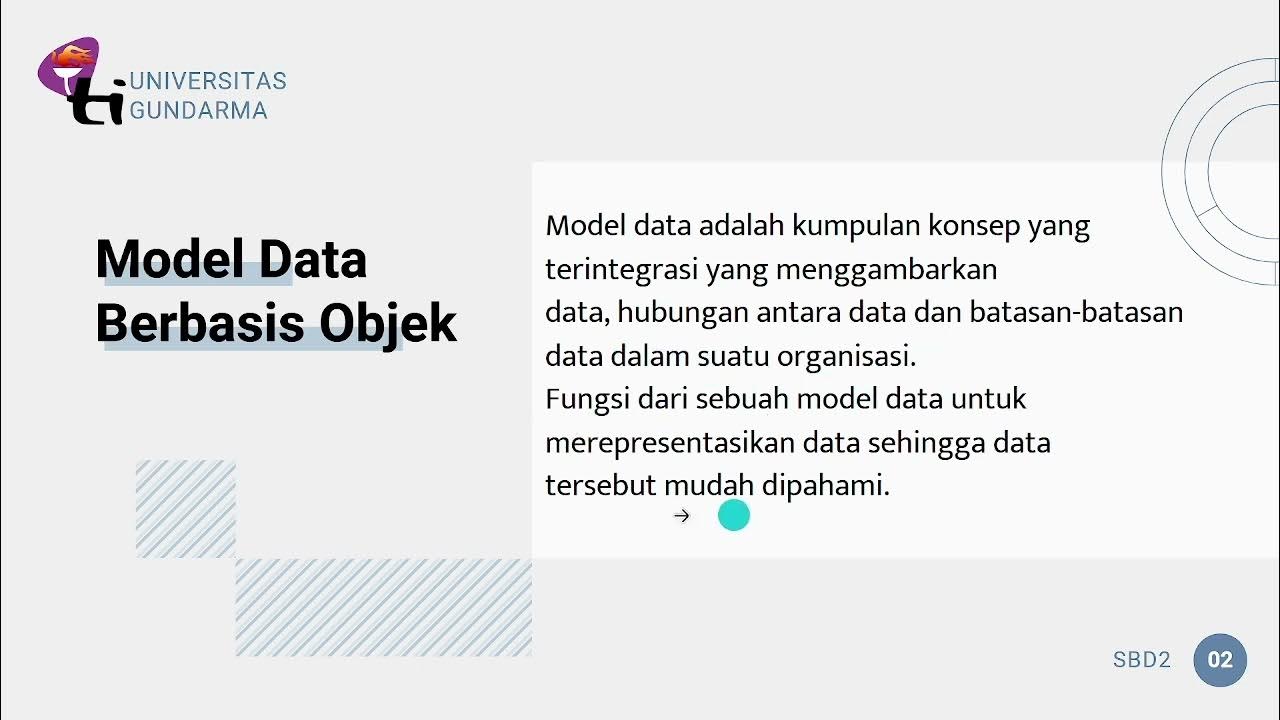PostgreSQL in 100 Seconds
Summary
TLDRThis video provides a concise overview of PostgreSQL, a trusted name in open-source relational databases. Developed in 1986 at UC Berkeley, PostgreSQL supports traditional table structures and advanced features like custom data types, inheritance, and polymorphism. Its multiversion concurrency control allows multiple transactions to run simultaneously. The database is highly extensible, supporting languages beyond SQL, like Python and C, and offers powerful extensions like PostGIS for geospatial data. It’s cloud-friendly, with platforms like Neon offering autoscaling and advanced management features. The video demonstrates creating custom data types, arrays, JSON, and key-value pairs.
Takeaways
- 📅 PostgreSQL's development began in 1986 at UC Berkeley under Michael Stonebraker.
- 🗄️ It is an object-relational database, capable of creating custom data types with properties and supports advanced features like inheritance and polymorphism.
- ⚡ PostgreSQL supports ACID-compliant transactions and uses Multiversion Concurrency Control (MVCC) to allow multiple transactions to run simultaneously without locking.
- 📈 Developers appreciate PostgreSQL's extensibility, including reusable queries through stored procedures and support for languages beyond SQL like Python and C.
- 🌍 The database has a robust ecosystem of extensions, such as PostGIS for geospatial data, used in applications like Uber.
- 🔑 PostgreSQL supports unique primary keys for each table and enables relationships between tables using foreign keys.
- 📊 PostgreSQL provides advanced data modeling options like arrays, JSON, and even key-value pairs using the Hstore extension.
- ☁️ Neon DB offers a free cloud-based PostgreSQL instance with autoscaling and a user-friendly UI to manage data.
- 🔄 PostgreSQL allows complex join queries, such as linking multiple tables through foreign keys for more advanced data retrieval.
- 🛠️ PostgreSQL enables custom data types and the ability to insert and query structured and unstructured data efficiently.
Q & A
What is PostgreSQL, and how is it different from other relational databases?
-PostgreSQL is an open-source object-relational database that supports advanced features like custom data types, inheritance, and polymorphism. Unlike pure relational databases, PostgreSQL allows for object-oriented elements such as defining objects with properties.
When was PostgreSQL first developed, and who was behind its creation?
-PostgreSQL's development dates back to 1986 at UC Berkeley, under the direction of Michael Stonebreaker.
What are some of the key features of PostgreSQL that make it unique?
-PostgreSQL offers features such as custom data types, multiversion concurrency control (MVCC), support for advanced data modeling options like arrays and JSON, as well as support for languages beyond SQL, such as Python and C.
What is Multiversion Concurrency Control (MVCC), and how does it work in PostgreSQL?
-MVCC is a feature in PostgreSQL that allows multiple transactions to run simultaneously by giving each transaction a snapshot of the database. This avoids traffic jams and locks, ensuring smooth concurrent transactions.
How does PostgreSQL handle extensibility and integration with other programming languages?
-PostgreSQL is highly extensible, supporting the reuse of queries via stored procedures and integration with languages like Python and C. This flexibility allows developers to extend its functionality beyond traditional SQL operations.
What are some of the advanced data modeling options available in PostgreSQL?
-PostgreSQL supports advanced data modeling options, including arrays, two-dimensional arrays, JSON data types for unstructured data, and key-value pairs through extensions like h-store.
How does PostgreSQL manage relationships between tables, and what is an example of a relationship?
-PostgreSQL manages relationships between tables using foreign keys. For example, a table representing programmers might store the programmer's primary key as a foreign key in a table representing Lambos they own. A join query can be used to find the Lambos owned by a particular programmer.
What are some popular extensions available for PostgreSQL, and how do they enhance its capabilities?
-Popular extensions for PostgreSQL include PostGIS, which provides geospatial data support for applications like Uber, and h-store, which allows handling key-value pairs. These extensions enhance PostgreSQL's flexibility for handling specific types of data.
What options are available for setting up PostgreSQL, and which method is recommended for beginners?
-PostgreSQL can be downloaded and installed locally, but for beginners, using a free cloud database like Neon is recommended. Neon provides auto-scaling and a user-friendly interface to manage data.
What is a key advantage of using PostgreSQL in AI-related applications?
-PostgreSQL supports extensions like PG-Embedding, which can give AI chatbots long-term memory, making it suitable for AI-related applications that require persistent storage of complex data structures.
Outlines

このセクションは有料ユーザー限定です。 アクセスするには、アップグレードをお願いします。
今すぐアップグレードMindmap

このセクションは有料ユーザー限定です。 アクセスするには、アップグレードをお願いします。
今すぐアップグレードKeywords

このセクションは有料ユーザー限定です。 アクセスするには、アップグレードをお願いします。
今すぐアップグレードHighlights

このセクションは有料ユーザー限定です。 アクセスするには、アップグレードをお願いします。
今すぐアップグレードTranscripts

このセクションは有料ユーザー限定です。 アクセスするには、アップグレードをお願いします。
今すぐアップグレード関連動画をさらに表示

PostgreSQL (1) Installation and Create Your First Database ( SQL shell / PgAdmin4 )

SBD1 Pertemuan 1 | 3IA09,3IA10,3IA11,3IA13,3IA16

SBD1 Pertemuan1 | 3IA03 & 3IA04

Types of Databases: Relational vs. Columnar vs. Document vs. Graph vs. Vector vs. Key-value & more

PostgreSQL: Tudo o que você precisa saber sobre esse poderoso sistema gerenciador de bancos de dados

The Open Source Geospatial Community, PostGIS, & Postgres | POSETTE 2024
5.0 / 5 (0 votes)
